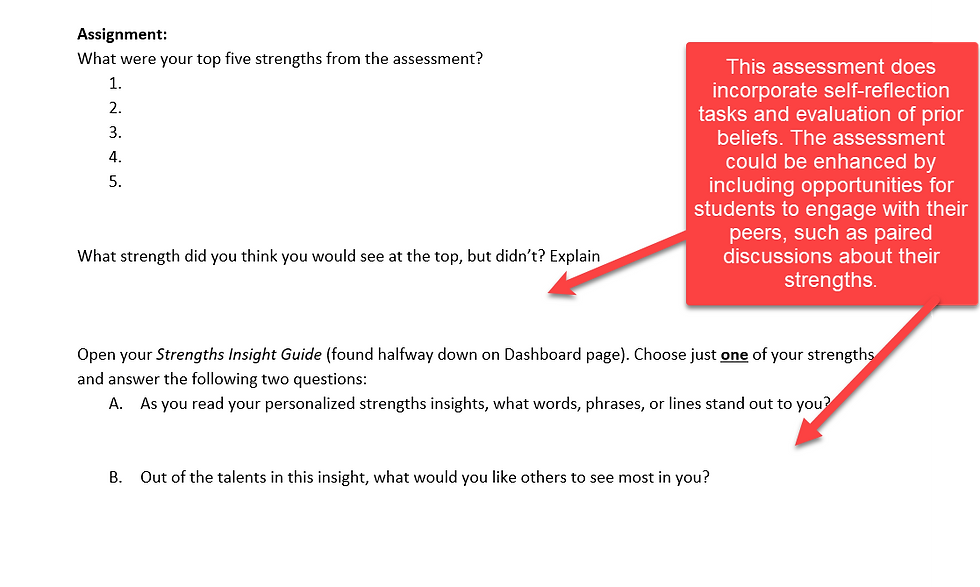Assessment Renovation
- Kaitlin

- Nov 17, 2020
- 3 min read
Updated: Nov 18, 2020
In today's blog, I am analyzing an assessment I have used in the past when teaching a freshman seminar course. The freshman seminar was focused on preparing students for professional health programs, such as medical or dental school. In addition to understanding the application process for health programs, I incorporated student success activities to help new freshmen adjust to college life. During the very first day of class each semester, I have my students complete a strengths assessment using Gallup's CliftonStrengths (previously known as StrengthsFinder 2.0). After my students complete the initial assessment to identify their top 5 strengths, I ask them to reflect on these strengths using the questionnaire below.
This image is the original assessment, which includes directions for accessing CliftonStrengths and is then followed by a list of reflection questions.

Review of the Original Assessment
The following three images include how I would renovate this particular assessment, ensuring that it is more equitable and accessible for my students. I want to highlight here that I had made quite a few assumptions in this initial assessment, specifically in regards to students being able to access CliftonStrengths, having the time to complete it, and being able to afford it. As Kara Newhouse stated in her article, Why Grading Policies For Equity Matter More Than Ever (2020), "while some students are learning in homes with abundant resources and parental support, others are sharing devices or bandwidth, taking care of siblings, or fitting school work around jobs." I think these are common assumptions in many classrooms and I really wanted to address them here.

The second image notes that self-reflection and self-regulation are incorporated into this assessment, but it is missing the element of peer feedback. In past sections in which I gave out this assessment, I've had a few students respond very negatively about their particular strengths. Some students felt their strengths weren't strengths at all! Offering opportunities to discuss their strengths with a peer can help to alleviate some of those concerns and learn that we all have unique skills that can make significant contributions.

The final image notes that the scope of the questions should be narrowed to the classroom setting and clearly explained, which helps to have a common knowledge base for all students. As Dr. Steinke and Dr. Fitch discussed in their article, Minimizing Bias When Assessing Student Work (2017), "explanations are types of knowledge structures enacted when a pre-existing knowledge structure is not available." It's important to remember that students will be entering the classroom with a wide range of experiences and knowledge, so we should be mindful of any assumptions made in an assessment and provide clear directions that all students can understand.

Updated Assessment
After completing the review of the original assessment, it's time to renovate! The next three images describe what changes were made to improve accessibility and equitable practices. Overall, this was an incredibly valuable learning experience for me and opened my eyes to how my current assessments made quite a few assumptions. This is a practice I plan to do with each assessment I create in the future.



References:
Fitch, P., Steinke, P. (2017). Minimizing bias when assessing student work. Research and Practice
in Assessment, 12, 87-95. This is focused on higher education.
Newhouse, K. (2020). Why grading policies for equity matter more than ever. Mindshift.
ever.



Comments